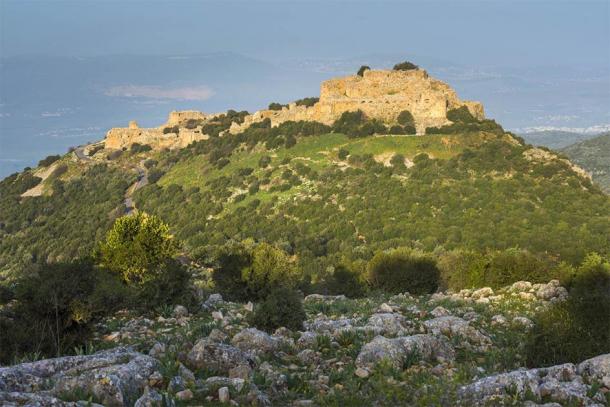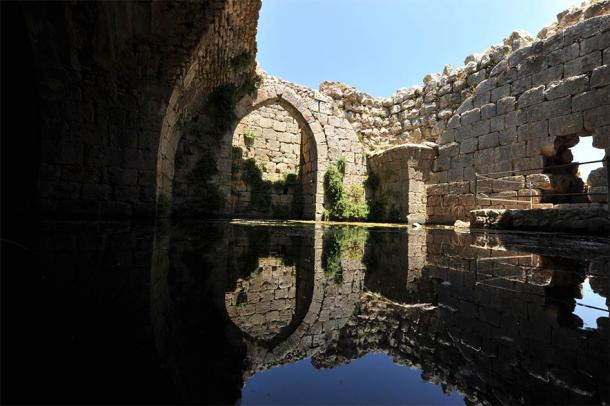Because of the thousands of years of human occupation, the Levant is an area rich in ruins and archaeological sites. One of the most fascinating medieval sites in the region is the castle known as Nimrod Castle, a is well preserved 13 th century fortress. It is located in the Golan Heights , which is currently administered by Israel but was in the past part of Syrian territory. The international community does not recognize Israel’s right to govern the Golan Heights.
Nimrod Castle- Medieval Fortress Shrouded in Myths
Nimrod Castle ( Qal’at Namrud in Arabic), is located on a strategic site that once overlooked important trade routes. There are a great many myths and stories told about this castle, including that it was built by Crusaders. It was, however, built by Al-Aziz Uthman a nephew of Saladin, the founder of the Ayyubid Dynasty in around 1228.
It was constructed in order to prevent the Crusaders of the 6 th Crusade from attacking Damascus. Due to the pressure of time, the Ayyubids used an economical method of building, and the castle was erected within only three years. The fortress was never directly attacked by the Crusaders but was later extended to contain an entire ridge on the southern slopes on Mount Hermon.

The cliff covered by Nimrod Castle, Golan ( John Theodor / Adobe Stock)
In 1260 the Mongols attacked Syria and seized the castle, destroying some of its defenses. The son of Al-Aziz Uthman was allowed to rule the castle and the surrounding lands as a vassal of the Mongols.
The Mamluks defeated the Mongols at the Battle of Ain Jalut in 1260 and captured the castle. The Mamluk Sultan, Baibars, gave the castle to one of his generals, Bilik, who rebuilt much of the stronghold as part of an effort to contain the Mongols. He was later assassinated on the orders of Baibars’ son and successor.
After the expulsion of the Crusaders from Acre, the castle no longer had any strategic significance. It later fell into the hands of the Ottomans who used it as a penitentiary, mainly for imprisoning nobles.

Hall in the lower tier in Nimrod Castle located in Upper Galilee in northern Israel on the border with Lebanon. ( svarshik / Adobe Stock)
An 18 th century earthquake resulted in the castle being abandoned and it became the home of shepherds and their flocks. The castle got its present name from Syrian Druze refugees who fled to the Golan Heights after a sectarian civil war in 1860 in Lebanon and Syria. They named the castle after Nimrod, a biblical king and great hunter. Israel captured the Golan Heights from Syria in the Six-Day War.
Nimrod Castle: Fortress on the Cliff
The fortress is in reality a complex and today dominates an entire ridge and much of it is perched on a cliff edge . The entire fortress is 1300 feet (420 m) long by 500 feet (160m) wide and built out of massive square, stone blocks.
The extensive walls are dotted with distinctive rectangular and circular towers, many of which have cross-arches on their rooves. Loopholes or ‘slits’ in the walls enabled archers to fire arrows at attackers.
At the eastern side of the fortress is a moat that protected the fortress at a vulnerable point. There is also a large keep or tower that measured 200 x 150 feet (63 x52m) and is situated on a height. The keep and the surrounding area was the citadel of the castle.
The fortress was once the residence of powerful lords who built pools, baths, and vast halls. The main fortress entrance is in the west and there are a number of underground passageways with cisterns that were constructed to allow defenders to hold out during a lengthy siege. Also, in the western section, is a smaller fortress that has a moat and once had a drawbridge. An incredible 90 arches grace the complex and they were so well built that they survived several earthquakes.

Ancient reservoir for collecting rain water in the Nimrod castle , Golan heights, Israel ( PROMA / Adobe Stock)
Getting to Nimrod Castle, Golan Heights
Today the site is administered by the Israel Nature and Parks Authority and visitors can explore the excavated and restored portions of the fortress. It is located in the Nimrod Fortress National Park which has many beautiful walks and views of the Golan and Galilee. The fortress is close to the ruins of Banias, an ancient town that was first mentioned in 200 BC.
Top image: The Nimrod Castle – remains of a medieval Ayyubid castle located on the southern slopes of Mount Hermon, overlooking the Golan Heights, lit up by morning sunlight
Source: Alexey Stiop / Adobe Stock
By Ed Whelan
References
Hinzen, K. G., Schwellenbach, I., Schweppe, G., & Marco, S. (2016). Quantifying Earthquake Effects on Ancient Arches, Example: The Kalat Nimrod Fortress, Dead Sea Fault Zone . Seismological Research Letters, 87(3), 751-764
Available at: https://scholar.google.com/scholar?hl=en&as_sdt=0%2C5&q=nimrod+castle+golan+heights&oq=
Margalit, A. (2018). Differential earthquake footprints on the masonry styles at Qal’at al-Subayba (Nimrod fortress) support the theory of its ancient origin . Heritage Science, 6(1), 1-13
Available at: https://heritagesciencejournal.springeropen.com/articles/10.1186/s40494-018-0227-9
Tsioni, G. (2010). A Mameluke Grape-Honey Treading Installation in the Golan Heights, Israel . Israel Exploration Journal, 222-244
Available at: https://www.jstor.org/stable/27927265
Related posts:
Views: 0
 RSS Feed
RSS Feed

















 September 23rd, 2020
September 23rd, 2020  Awake Goy
Awake Goy  Posted in
Posted in  Tags:
Tags: 
















